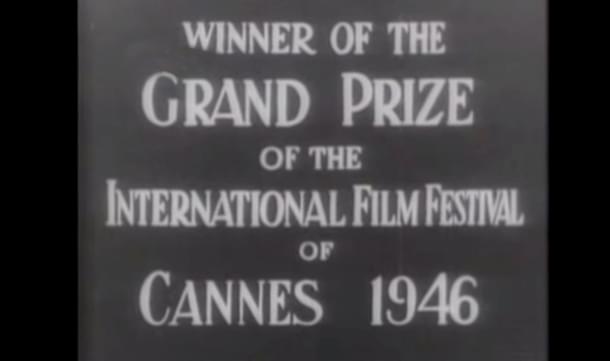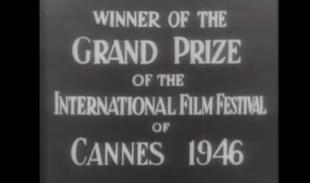Culture
This Indian Film Won The Highest Prize In Cannes In 1946, But Still Remains Forgotten
Gautam Chintamani
Sep 30, 2016, 05:58 PM | Updated 05:58 PM IST
Save & read from anywhere!
Bookmark stories for easy access on any device or the Swarajya app.


It was almost seventy years ago that the world witnessed the birth of the greatest film platform on the planet, the Cannes Film festival. Amongst the many things that the mere mention of the festival brings to mind one image continues to be conspicuously missing. While one might not associate the late Chetan Anand with the glitzy film festival, he holds the unique distinction of being amongst the first recipients of the festival's highest honor at the first ever Cannes Film Festival in 1946. Then called the Grand Prix du Festival International du Film, Anand’s Neecha Nagar (1946), which also happened to his directorial debut, shared the top honor with Roberto Rossellini’s Rome Open City (1945) and was perhaps the first-ever Indian film to leave an impression on the West when it came to cinema that portrayed Indian life. Anand’s film also holds the distinction of being the first film for which sitar maestro Pandit Ravi Shankar composed music. Imagine the reaction if an Indian film were to win the Palme d’Or at Cannes today but Neecha Nagar simply sank into obscurity in spite of winning an honor that should have propelled both the filmmaker as well as the film to great heights.
Anand was an unlikely and, to a great extent, even an accidental filmmaker. The Gurdaspur born son of a lawyer, Anand went to Government College, Lahore and then to Cambridge and followed it up with a scholarship to London University before finally ending with a fellowship at Doon. He taught English, History and, interestingly enough, tennis while at Doon besides playing the violin. Anand had married Uma, the daughter of G. C. Chatterji, his principal at Lahore and a man he often considered his mentor. And, then suddenly one fine day Anand shifted to Bombay with the idea of making films. He had no experience in cinema but this thirst for the arts and his close association with members of Indian Peoples Theatre Association (IPTA) gave him the confidence to forge ahead. Neecha Nagar featured Kamini Kaushal, whose real name was Uma Kashyap but Anand rechristened her in order to avoid confusion with the ‘other’ Uma, his wife and the lead of the film.
Inspired by Maxim Gorky’s Lower Depths, the expressionist Neecha Nagar looked at the gulf between the rich and the poor and was written by Hayatullah Ansari with dialogues by K.A. Abbas. The film’s story of a rich man trying every trick in the book to grab the land belonging to poor villagers is as relevant today as it was seven decades ago. In Neecha Nagar the rich man or Sarkar (Rafi Peer) wants the land occupied by poor villagers to construct modern apartments and diverts a dirty stream through the village to force them to move away. But they refuse to budge even when an epidemic breaks due to the dirty water that claims many lives including the idealist leader Balraj’s (Rafiq Anwar) sister Rupa (Kamini Kaushal). Sarkar then tries to bribe them, trick them and coerce them but nothing comes of it. Sarkar’s daughter, Maya (Uma Anand) joins the villagers in their struggle.
Anand’s nonchalance when it came to filmmaking and his background infuses a brilliant sense of modernism in the narrative and transforms the old as the hills theme into something contemporary. The women in the film match step with the rest in order to fight for their rights and contribute equally. In the pre-independent India when the film was made the rich man perched high above the others can be seen as a stand-in for the British, little surprise that he is called Sarkar and the villagers can be seen as the common Indians with Balraj probably modeled on Jawaharlal Nehru[1]. While the film is seen as one of the pioneering works to represent neo-realism in Indian cinema, Anand himself thought differently. In a later retrospective glance at Neecha Nagar Anand is said to have called it “pretentious”, but perhaps this harshness could have seeped in as a result of how the film’s destiny unfolded. Anand could not find any takers for the films even after the roaring success at Cannes and had it not been for the efforts of Pandit Nehru the film might not have even had a proper release but even then it barely managed to make an impression on Indian audiences.
Much like Neecha Nagar, K.A. Abbas’ Dharti Ke Lal (1946) and Bimal Roy’s Do Bhiga Zamin (1953) are amongst the first few films that come to mind when one thinks of realism in Hindi cinema. And, again mirroring each other all three did not exactly set the box office ablaze and while the latter two have somewhere managed to create a place for themselves in the annals of discussions and debates, Anand’s Neecha Nagar continues to be ignored. In the book National Identity in Indian Popular Cinema, 1947-1987 author Sumita S. Chakravarty mentions that the themes that these three films explore – the struggle between the haves and have-nots (Neecha Nagar), the country and the city (Dharti Ke Lal) and the tenant/ peasant and the landlord or the moneylender (Do Bigha Zamin) – can all be found in Bimal Roy’s Bengali hit Udayer Pathe (1944), which was remade in Hindi as Humrahi (1945)[2]. The highly socially conscious and nationalist, Udayer Pathe followed traditions that had already been set in Indian film narrative of the period but what made it popular among the masses was the manner in which it used a very conventional trope (poor boy meets rich girl) to convey a realist concept.
The failure of Neecha Nagar saw Chetan Anand change the trajectory of his filmmaking. The shift was to such a degree that when his youngest brother, Vijay ‘Goldie’ Anand wanted to embark on a career in films, Chetan’s wife Uma told him that it would mean compromising at every stage. In an interview with Nasreen Munni Kabir, Goldie Anand said that according to Uma, post-Neecha Nagar Chetan had been constantly compromising. Neecha Nagar’s tragedy did not end with its abysmal failure at the box office. The film’s producer, A. Halim, migrated to Pakistan following the partition and took the negative of the film along with him and for Indians, it was considered lost till a print was discovered by cinematographer Subrata Mitra when he picked up a can of rotting film in a junk shop.
In a day and age when any Indian film that is even screened officially at Cannes makes news and Neecha Nagar, a film that won the festival’s highest honor at the first-ever edition continues to remain forgotten. Neecha Nagar’s expressionist imagery, the heavily symbolic props, and the high key lighting would all serve as inspiration fro Raj Kapoor’s seminal Awaara (1951)[3]. Such is the tragedy of a film that moved the then up and coming filmmaker Satyajit Ray to write a letter to Chetan Anand saying that he had been inspired by the latter's Neecha Nagar to continue striving to make his own first film, Pather Panchali (1955).
Gautam Chintamani is the author of ‘Dark Star: The Loneliness of Being Rajesh Khanna’ (2014) and ‘Qayamat Se Qayamat Tak- The Film That Revived Hindi Cinema’ (2016)





